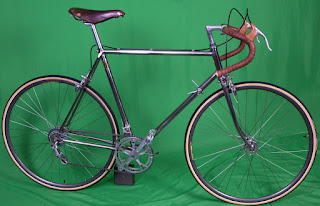Eddy Merckx said it was the toughest world title race in which he was ever involved.
He did it on this bike:

Today, I rode it on this bike:
All right, I didn't ride the whole race, or anything close to it. However, I rode over what might have been the toughest parts.
And I did it on that bike. Mind you, it's not bad, especially as rental bikes go. In fact, I'd say it's the nicest bike I've rented. As researchers would say, I have a limited sample size: In plain English, I haven't rented a lot of bikes. Still, I feel confident in my judgment.
But it's certainly not Mercx's DeRosa. And, oh yeah, he was half my age when he did the climbs of Mont Royal.
You see, "le Mont" isn't a single climb. It's really two hills, separated by a depression that resembles an ancient dormant volcano. Except that, according to scientists, it never was a volcano: The "twin towers" were the result of some unusual erosion patterns.
The first climb takes you up to the visitors' center at Maison Smith and to the trails that lead to the broadcast tower and this:
La Croix is visible from much of the city, especially on clear nights. Yes, I rode to it and, since I don't do "selfies", I asked an anonymous stranger to take this photo:
Then I took another trail to the observation area
and another trail to the other part of the mountain, near the McGill University campus.
Then, after exiting the trails at the Avenue des Pins, I did some more climbing into the Cote de Neige (Yes, there's skiing and snowboarding in the area!) and the mansions of Westmount.
As Mercx and others remarked, the mountains aren't very high. So, the climbs aren't long. But they're pretty steep, as many paved-over old roads are. And, having to do them in sucession, as I did today, wore out some of the world's best rider in that epic 1974 race, the first World's Championship held in North America.
At least today's ride was, if chilly (high temperature: 10C, or 50 F), at least gorgeous: Yesterday's rains seemed to have cleared the sky of clouds. And, because it's well into autumn here, north of the 45th parallel (New York City is at the 40th), the sun didn't seem very intense, even with such a clear sky.
Before and after the climbs and descents, I rode, almost at random, through various parts of the city, and into a couple of its suburbs. I don't know how many kilometers I did today, but I can pretty safely say I rode. And I definitely enjoyed it, and this city, which I hadn't seen in about fifteen years before this trip.
He did it on this bike:
Today, I rode it on this bike:
All right, I didn't ride the whole race, or anything close to it. However, I rode over what might have been the toughest parts.
And I did it on that bike. Mind you, it's not bad, especially as rental bikes go. In fact, I'd say it's the nicest bike I've rented. As researchers would say, I have a limited sample size: In plain English, I haven't rented a lot of bikes. Still, I feel confident in my judgment.
But it's certainly not Mercx's DeRosa. And, oh yeah, he was half my age when he did the climbs of Mont Royal.
You see, "le Mont" isn't a single climb. It's really two hills, separated by a depression that resembles an ancient dormant volcano. Except that, according to scientists, it never was a volcano: The "twin towers" were the result of some unusual erosion patterns.
The first climb takes you up to the visitors' center at Maison Smith and to the trails that lead to the broadcast tower and this:
La Croix is visible from much of the city, especially on clear nights. Yes, I rode to it and, since I don't do "selfies", I asked an anonymous stranger to take this photo:
Then I took another trail to the observation area
and another trail to the other part of the mountain, near the McGill University campus.
Then, after exiting the trails at the Avenue des Pins, I did some more climbing into the Cote de Neige (Yes, there's skiing and snowboarding in the area!) and the mansions of Westmount.
As Mercx and others remarked, the mountains aren't very high. So, the climbs aren't long. But they're pretty steep, as many paved-over old roads are. And, having to do them in sucession, as I did today, wore out some of the world's best rider in that epic 1974 race, the first World's Championship held in North America.
At least today's ride was, if chilly (high temperature: 10C, or 50 F), at least gorgeous: Yesterday's rains seemed to have cleared the sky of clouds. And, because it's well into autumn here, north of the 45th parallel (New York City is at the 40th), the sun didn't seem very intense, even with such a clear sky.
Before and after the climbs and descents, I rode, almost at random, through various parts of the city, and into a couple of its suburbs. I don't know how many kilometers I did today, but I can pretty safely say I rode. And I definitely enjoyed it, and this city, which I hadn't seen in about fifteen years before this trip.


















